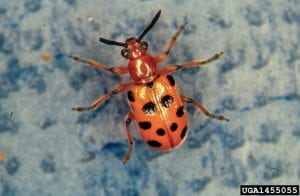There are two beetle pests that feed on asparagus, the common or striped asparagus beetle (Crioceris asparagi) and the spotted asparagus beetle (Crioceris duodecimpunctata). Feeding on the spears results in scarring, browning, and hooked tips render the crop unmarketable. While both beetles can damage the emerging spears, the common asparagus beetle larvae and adults will also feed on the ferns, which can reduce the plant’s ability to build resources for a strong crop the following spring.


Photo by Whitney Cranshaw, Colorado State University, Bugwood.org
Adults: Adult beetles are about ⅓ inch in length. The adult common asparagus beetle is blue-blackish with six cream-colored square-shaped spots on its back (Fig 1). Adult spotted asparagus beetles are reddish-orange with twelve black spots on their back (Fig 2). Both the beetles overwinter as adults.

Eggs: Eggs take about a week to hatch. They are small, cylindrical, and dark-colored. The asparagus beetle lays eggs on the spear at a 90-degree angle in rows of 3 to 8 eggs (Fig 3.), while the spotted asparagus beetle oviposits eggs singularly on the fern.

Larvae: The larvae of both species are light gray with visible heads and legs. The common asparagus beetle larvae have blackheads (Fig 4.), while the spotted asparagus beetle larvae have an orange head. Larval feeding lasts for 10-14 days. Asparagus beetle larvae feed on the spear, while spotted asparagus beetles will burrow into the berry. Mature larvae crawl to the ground and burrow within the soil to pupate.
Scouting: Scouting should start at the end of April – early May or just after asparagus plants emerge and continue for the rest of the growing season. Check 10 plants in 5-10 different locations in a field, best on a warm, sunny afternoon when beetles will be most active. Treatment may be justified if 10% of spears are infested with beetles or 1-2% have eggs.
Cultural Controls & Prevention:
- During harvest, harvest all spears every day to reduce the number of stems where eggs will survive for long enough to hatch.
- Allow plants in one area to develop ferns so as to act as a trap crop. These plants can then be sprayed selectively.
- Maintain a clean environment in asparagus fields in the fall to force adults to overwinter in field edges where natural predators reside.
- Destruction of crop residues will eliminate overwintering sites for asparagus beetles.
- The most important natural enemy of the common asparagus beetle is a tiny parasitic wasp (Tetrastichus asparagi) that attacks the egg stage. These parasitoids lay their own eggs inside the beetle eggs. The immature wasps grow inside the beetle larvae, killing them when they pupate. Studies have found >50% of eggs were killed by parasitoid feeding, and half of the surviving larvae were parasitized. Providing a nearby nectar source such as umbelliferous flowers may enhance wasp populations.
Chemical Control
- Organic options on spears include Surround WP as a repellent, EC5.0, or products containing capsaicin (check for certification status).
- If possible, spot spray along edges of planting where overwintering adults colonize the field and/or band insecticide over the row to help spare natural enemies. Use selective insecticides on ferns.
- Daily harvest of asparagus makes chemical treatment difficult. 1 dh products are available and can be used immediately after picking to allow harvest the following day (see the Mid-Atlantic Commercial Vegetable Production Recommendations for current recommendations)
E. Zobel